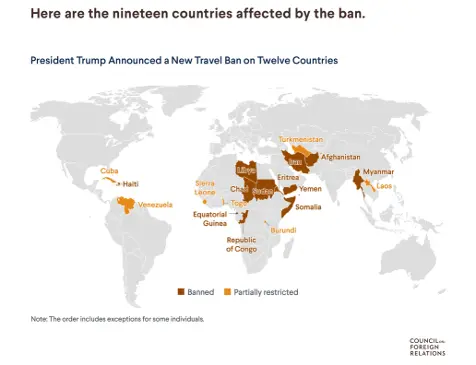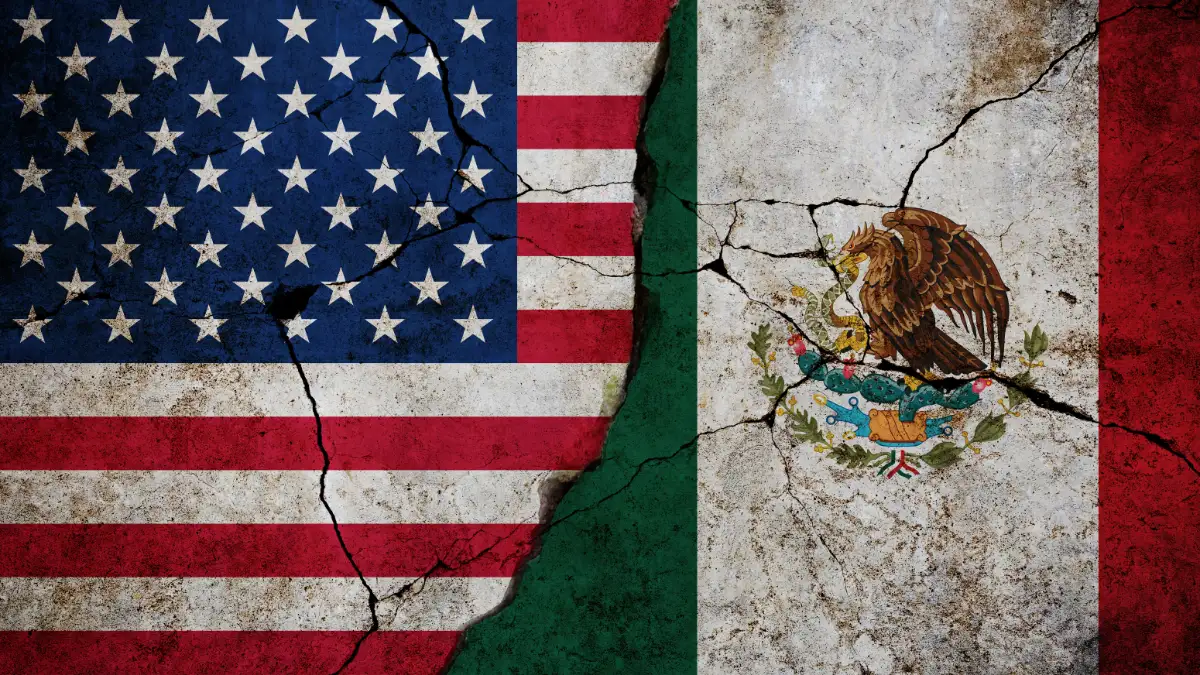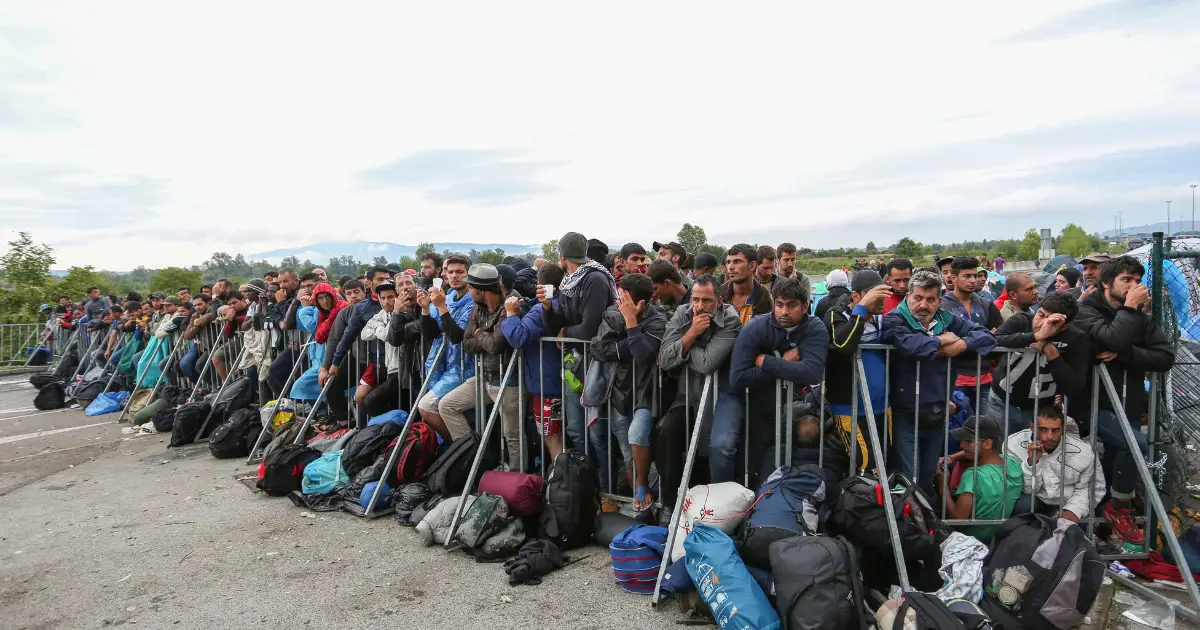In the nation’s capital in June 2025, with the flourish of a pen, President Trump unveiled his latest travel ban entitled “Restricting the Entry of Foreign Nationals to Protect the United States” (2025). (See https://www.whitehouse.gov/presidential-actions/2025/06/restricting-the-entry-of-foreign-nationals-to-protect-the-united-states-from-foreign-terrorists-and-other-national-security-and-public-safety-threats/.)
The news rippled across continents faster than a speeding bullet leaving would-be travelers, lawyers, and late-night comedians scrambling for their passports, legal briefs, and punchlines. This essay explores the legal, political, and human drama of the 2025 travel ban, weaving in personal stories and the occasional satirical wink, because, as any good playwright—or president—knows, tragedy and farce often walk hand in hand.
The Proclamation fully restricts and limits the entry of nationals from 12 countries found to be deficient with regards to screening and vetting and determined to pose a very high risk to the United States: Afghanistan, Burma, Chad, Republic of the Congo, Equatorial Guinea, Eritrea, Haiti, Iran, Libya, Somalia, Sudan, and Yemen.
The Proclamation partially restricts and limits the entry of nationals from 7 countries who also pose a high level of risk to the United States: Burundi, Cuba, Laos, Sierra Leone, Togo, Turkmenistan, and Venezuela.
The Proclamation includes exceptions for lawful permanent residents, existing visa holders, certain visa categories, and individuals whose entry serves U.S. national interests. (See White House Fact Sheet at https://www.whitehouse.gov/fact-sheets/2025/06/fact-sheet-president-donald-j-trump-restricts-the-entry-of-foreign-nationals-to-protect-the-united-states-from-foreign-terrorists-and-other-national-security-and-public-safety-threats/.)
Legal Foundations: INA Section 212(f) and US Supreme Court Precedent
The travel ban is based on the Immigration and Nationality Act, specifically sections 212(f) and 215(a). These sections grant the President the power to suspend the entry of noncitizens when their presence is deemed “detrimental”—a term as flexible as a campaign promise.
The Supreme Court’s 2018 decision in Trump v. Hawaii gave the executive branch a green light, or perhaps a blank check, to restrict entry on national security grounds, provided the policy is facially neutral. In other words, if the travel ban were a play, the Court’s role was to stay backstage, trusting the director’s vision, however unconventional. The international community has raised concerns about discrimination and the right to seek asylum.
The List: Who’s In, Who’s Out, and Who’s Just Confused
The 2025 ban targets 19 countries: 12 face a total blackout, while 7 receive the “partial ban” treatment—a bureaucratic limbo comparable to being stuck on hold with customer service. See Figure 1.0 below.
| Category | Number of Countries | Nature of Ban | Notable Features |
| Full Ban | 12 | All visas suspended | Applies to immigrants and visitors |
| Partial Ban | 7 | Selective restrictions | Certain visa types/categories limited |
Figure 1.0
The 12 countries with near-complete visa restrictions are:
- Afghanistan
- Burma
- Chad
- Republic of the Congo
- Equatorial Guinea
- Eritrea
- Haiti
- Iran
- Libya
- Somalia
- Sudan
- Yemen
Subject to the exceptions listed below, restrictions on nationals of these countries include a total ban on entry and a total ban on visa issuance. This includes people seeking an immigrant visa (which results in lawful permanent residency upon arrival to the U.S.) or any non–immigrant visa category (which includes temporary visitors, guest workers, and students, among others). All people in these categories are prohibited from entering the United States, even those waiting to permanently migrate to the U.S. to reunite with family or through employment.
The seven countries with partial visa restrictions are:
- Burundi
- Cuba
- Laos
- Sierra Leone
- Togo
- Turkmenistan
- Venezuela
Figure 2.0 below provides a color-coded map showing the affected countries.

Figure 2.0 – Source: Council on Foreign Relations
Subject to the exceptions listed below, the restrictions on nationals of these countries include a total ban on visa issuance for people seeking an immigrant visa, and a partial ban on visa issuance for people seeking certain non–immigrant visas. Specifically, this ban applies to people who have applied for the following non–immigrant visas: B-1 (business visitor), B-2 (tourist), F and M (international students), and J (exchange visitor) visas.
That means that nationals of the countries with partial restrictions seeking to obtain other non–immigrant visas after June 9, 2025, are not subject to the ban, including those seeking visas as specialty occupation workers (H-1B), intracompany transferees (L-1) and fiancés (K-1). However, for individuals seeking visas in non-banned categories, consular officers are instructed to “reduce the validity [period] for any other nonimmigrant visa… to the extent permitted by law.”
Who Is Not Covered by the Travel Ban?
Importantly, this ban is prospective — it does not apply retroactively to individuals who obtained a visa before June 9, 2025, even if they were outside the U.S. on that date. Individuals with valid visas who are inside the United States before June 9, 2025, are also not impacted — their visas will remain valid and effective. Additionally, the proclamation states that no immigrant or non–immigrant visa issued before the effective date can be revoked under the proclamation.
There are also a number of exemptions from both bans carved out under Section 4(b) of the proclamation. These include:
- Lawful Permanent Residents (LPRs)
- Refugees, asylees, and individuals granted Withholding of Removal or protection under the Convention Against Torture
- Diplomats and NATO personnel
- Dual nationals (if traveling on a passport from a non-designated country)
- Immediate relatives (spouses, minor children, or parents of U.S. citizens who are at least 21 years old), with proof of their relationship
- Children adopted abroad
- Afghan Special Immigrant Visa (SIV) holders and U.S. government employee SIVs
- Immigrant visa applicants who are ethnic or religious minorities facing persecution in Iran
- Athletes, coaches and support staff, and immediate relatives of athletes participating in “major sporting events,” including the Olympics and the World Cup
- Individuals whose entry is deemed in the national interest by the U.S. Attorney General or Secretary of State
Individuals covered by one of these exemptions are not subject to the visa bans and should continue to be able to enter and to seek and obtain visas. However, individuals may be subject to additional screening or face other hurdles in obtaining visas that arise as a result of the travel bans.
Exemptions and Waivers
Some are specifically exempted from the travel ban to include Afghan nationals with Special Immigrant Visas for Afghans who assisted the U.S. in its military operations in Afghanistan. Some persecuted minorities in Iran are also exempted and immediate relatives of US citizens. Proving these exemptions, however, may be a practically difficult or even impossible in many cases. The travel ban provides for a waiver process for applying for and qualifying for these exemptions.
Review and Sunset
Every 90 to 180 days, the Secretary of State must review the list, offering hope for some countries—though, nothing is guaranteed.
The Rationale: US National Security and Visa Overstays
The proclamation justifies the travel ban by pointing to three primary issues. First is the assertion that certain countries lack robust procedures for sharing information and for thoroughly screening visa applicants, making it challenging for U.S. authorities to confirm individuals’ identities and backgrounds. Second, the administration refers to statistics from fiscal year 2023, as published in the U.S. Customs and Border Protection’s “Entry/Exit Overstay Report,” to argue that some nations have disproportionately high rates of nationals who overstay their temporary visas and remain in the United States without legal status. Third, the restrictions target so-called “recalcitrant” countries—those that fail to cooperate with U.S. efforts to repatriate citizens who have been ordered deported. While the first rationale previously gained support from the Supreme Court in Trump v. Hawaii, the latter two arguments represent new terrain. It is worth noting that current U.S. law already empowers the government to impose visa-related penalties on countries that refuse to take back their nationals, but this new proclamation appears to bypass those established procedures and instead leans on a broader executive authority.
Repatriation Non-Cooperation: The Diplomatic Cold Shoulder
Some countries don’t want their deported nationals back, so this travel ban is the U.S. response to their failure to cooperate.
Family Separation and Academic Fallout
For many, the travel ban is not a policy debate but a personal heartbreak. U.S. citizens and green card holders are separated from family members, sometimes forced to attend weddings, funerals, and graduations via Zoom.
There is a very real economic and academic fallout as well. Universities are experiencing a substantial loss of international students. One international student from Myanmar, accepted to an Ivy League university, described his plans as “uncertain as a reality TV plot twist.” Having secured his student visa just in time before the travel ban, he lamented that his family, thanks to the ban, would miss his graduation. Fatou Wurie, a doctoral student from Sierra Leone, planned to return to Boston for her dissertation defense. Instead, she watched her graduation online.
Lawsuits and Foreign Response
Lawsuits are already in the wings, with critics arguing the ban is more about politics than security. The administration, meanwhile, insists it’s all about “protecting Americans”—a phrase as can be elastic as a campaign slogan. Foreign governments have responded with everything from diplomatic protests to reciprocal restrictions, turning international relations into a game of tit-for-tat.
The Trump travel ban of 2025 is both a legal instrument and a human drama, a case study in the power of executive authority and the unintended consequences of sweeping policy. For some, it is a necessary shield; for others, an iron curtain drawn across the stage of life. As the world watches the next act unfold, one can only hope that future policies will favor dialogue over drama, and reunions over restrictions.
References
International Rescue Committee, “What is President Trump’s latest travel ban?” (2025).
American Immigration Council, “Analysis of Trump’s New Travel Ban” (2025).
Council on Foreign Relations, “A Guide to the Countries on Trump’s 2025 Travel Ban List” (2025).
Legal Aid NYC, “What You Need to Know About Trump’s June 2025 Travel Ban” (2025).
National Immigration Law Center, “Trump’s Newest Xenophobic Travel Ban” (2025).
NAFSA, “Presidential Proclamation Orders Travel Bans” (2025).
Washington Post, “Democrats blast Trump’s travel ban, but legal challenges may be difficult” (2025).
NPR, “Trump travel ban threatens college dreams for foreign nationals” (2025).
Harvard T.H. Chan School of Public Health, “Op-ed: Trump travel ban sends ‘chilling message’ to international students” (2025).
American Immigration Council, “President Trump’s New Travel Ban: What You Need to Know” (2025).
Chidolue Law, “Trump Travel Ban 3.0: Understanding the 2025 Restrictions and Their Impact” (2025).
NPR, “How Trump’s travel ban could disrupt the way knowledge moves around the world” (2025).
Stop AAPI Hate, “Statement: Stop AAPI Hate Condemns the Return of President Trump’s Travel Ban” (2025).
White House, “Restricting The Entry of Foreign Nationals to Protect the United States” (2025).
PLI, “Travel Ban 2025 – Overview, Impacts, and Legal Challenges” (2025).
MLFA, “President Trump’s June 2025 Travel Ban” (2025).
NPR, “How Trump’s travel ban could disrupt the way knowledge moves around the world” (2025).
https://www.americanimmigrationcouncil.org/fact-sheet/analysis-trump-travel-ban/
https://www.nilc.org/articles/trumps-newest-xenophobic-travel-ban
https://www.rescue.org/article/trump-latest-travel-ban
https://www.cfr.org/article/guide-countries-trumps-2025-travel-ban-list
https://www.npr.org/2025/06/11/nx-s1-5424642/trump-college-travel-ban-myanmar
https://www.washingtonpost.com/politics/2025/06/05/trump-travel-ban-countries-legal-challenges
https://mlfa.org/president-trumps-june-2025-travel-ban



